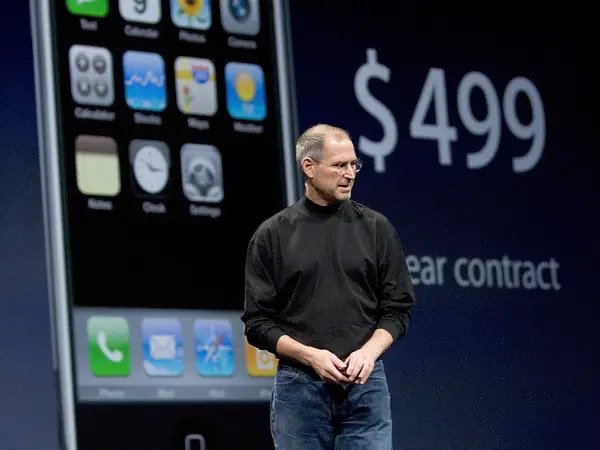
Golden Circle
Let’s analyze the “Golden Circle” speech structure with a focus on Steve Jobs’ 2007 iPhone Launch speech.
Let’s get started:
We’ve broken this speech structure analysis into two sections: an overview of the “Golden Circle” structure and an analysis of Steve Jobs’ 2007 iPhone Launch speech to see how he used it.
Overview
What is the “Golden Circle” structure and when do you use it?
This structure flips traditional logic by starting with the emotional core. Simon Sinek’s "Golden Circle" begins not with facts or plans—but with purpose. It targets the shared values or common goals of the audience first in order to build a foundation for your proposal later. In advocacy, it builds momentum by getting your audience to agree with you before persuading them on your advocacy.
This structure is best used when you’re rallying people around a mission or vision, especially if it’s new or bold. The “Golden Circle” speech structure is compelling for changemakers who want to inspire, not just inform.
Audience: New supporters, donors, early-stage activists.
Setting: Vision launches, fundraising events, introductory presentations.
Cause: Tech for good, youth-led initiatives, start-up advocacy, mutual aid projects.
Note: None of these speech structures are strict rules. They should serve as guidelines to help you write a speech or draft a testimony when you don’t know where to start. Even in the speech we’ll examine below, Steve Jobs incorporates and mixes elements of other structures, like the “Chronological” speech structure.
Why: Define your purpose. What value or belief drives you?
How: Describe the method, program, or mindset you use.
What: Lay out your proposal or action clearly.
Analysis
How did Steve Jobs use the “Golden Circle” structure in his speech?
Why?
At the core of Steve Jobs' 2007 iPhone launch speech is a powerful "Why" message: technology should be intuitive, delightful, and revolutionary. This purpose manifests throughout the presentation in several key moments:
"Every once in a while, a revolutionary product comes along that changes everything." Jobs positions the iPhone as more than just a product—it's part of Apple's mission to create transformative experiences that improve people's lives.
Jobs articulates the "Why" through frustration with existing smartphones:
"They're not so smart and they're not so easy to use."
This establishes the fundamental purpose: to solve real human problems that current technology is failing to address.
The "Why" becomes more evident when Jobs discusses the revolutionary user interface:
"We wanted to make a leapfrog product that is way smarter than any mobile device has ever been and super-easy to use."
The purpose isn't just to make another phone—it's to reimagine what a phone could be.
How?
Jobs transitions to "How" by explaining Apple's approach to solving these problems. Jobs explains how Apple has decided to achieve the goals and values he’s laid out— their philosophy, expertise, and design:
Leverage existing expertise: "iPhone runs OSX... It's got everything we need. It's got multi-tasking. It's got the best networking." Jobs emphasizes how Apple brings desktop computing power to a mobile device.
Reinvent the interface: "We've invented a new technology called multi-touch... It works like magic." The "How" is demonstrated through the touchscreen technology that eliminates physical keyboards.
Integration philosophy: Jobs quotes Alan Kay: "People who are really serious about software should make their own hardware." This captures Apple's approach of creating seamless experiences by controlling both hardware and software.
Strategic partnerships: "We've been working very closely with them," Jobs says about Google and Yahoo, illustrating how Apple works with partners to create a complete ecosystem.
The "How" becomes visual when Jobs demonstrates the phone's capabilities in real-time, showing not just telling the audience how Apple solves problems through design and functionality.
WHat?
Only after establishing "Why" and "How" does Jobs fully unveil "What" the product actually is:
"This is one device, and we are calling it iPhone."
The product reveal comes 9 minutes into the presentation, after the audience understands the purpose and approach.
Jobs then methodically details the product specifications, features, pricing, and availability:
"It's got a three-and-a-half-inch screen"
"We've got some really advanced sensors"
"For a 4 gigabyte model, we're going to price it at that same $499"
"We're going to be shipping these in June"
The "What" section is the longest portion but serves to validate the "Why" and "How" that preceded it. Each feature demonstration reinforces the core purpose of making technology more intuitive and revolutionary.
Read the full transcript of Steve Jobs’ 2007 iPhone Launch speech.
Watch the full Steve Jobs’ 2007 iPhone launch speech.
Steve Jobs uses a lot of rhetorical techniques and tools in his speech. To learn more about rhetoric, click here.

